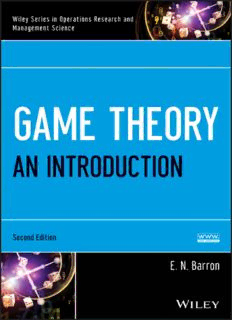Table Of ContentGame Theory
Wiley Seriesin
OPERATIONS RESEARCH AND MANAGEMENT SCIENCE
OperationsResearchandManagementScience(ORMS)isabroad,interdisciplinarybranch
ofappliedmathematicsconcernedwithimprovingthequalityofdecisionsandprocesses
andisamajorcomponentoftheglobalmodernmovementtowardstheuseofadvanced
analyticsinindustryandscientificresearch.TheWileySeriesinOperationsResearchand
ManagementSciencefeaturesabroadcollectionofbooksthatmeetthevariedneedsof
researchers,practitioners,policymakers,andstudentswhouseorneedtoimprovetheiruse
ofanalytics.ReflectingthewiderangeofcurrentresearchwithintheORMScommunity,
theSeriesencompassesapplication,methodology,andtheoryandprovidescoverageofboth
classicalandcuttingedgeORMSconceptsanddevelopments.Writtenbyrecognized
internationalexpertsinthefield,thiscollectionisappropriateforstudentsaswellas
professionalsfromprivateandpublicsectorsincludingindustry,government,andnonprofit
organizationwhoareinterestedinORMSatatechnicallevel.TheSeriesiscomprisedof
threesections:DecisionandRiskAnalysis;OptimizationModels;andStochasticModels.
(cid:2)
AdvisoryEditors DecisionandRiskAnalysis
GilbertoMontibeller,LondonSchoolofEconomics
GregoryS.Parnell,UnitedStatesMilitaryAcademyatWestPoint
FoundingSeriesEditor
JamesJ.Cochran,LouisianaTechUniversity
DecisionandRiskAnalysis
(cid:2)
Barron GameTheory:AnIntroduction,SecondEdition
ForthcomingTitles
(cid:2)
NussbaumandMislick CostEstimation:MethodsandToolsOptimizationModels
OptimizationModels
(cid:2)
Ghiani,Laporte,andMusmanno IntroductiontoLogisticsSystemsManagement,
SecondEdition
StochasticModels
Game Theory
An Introduction
SECOND EDITION
E.N. Barron
LoyolaUniversity Chicago
Chicago,Illinois
Copyright(cid:2)C 2013byJohnWiley&Sons,Inc.Allrightsreserved.
PublishedbyJohnWiley&Sons,Inc.,Hoboken,NewJersey.
PublishedsimultaneouslyinCanada.
Nopartofthispublicationmaybereproduced,storedinaretrievalsystem,ortransmittedinanyformorbyanymeans,
electronic,mechanical,photocopying,recording,scanning,orotherwise,exceptaspermittedunderSection107or108
ofthe1976UnitedStatesCopyrightAct,withouteitherthepriorwrittenpermissionofthePublisher,orauthorization
throughpaymentoftheappropriateper-copyfeetotheCopyrightClearanceCenter,Inc.,222RosewoodDrive,
Danvers,MA01923,(978)750-8400,fax(978)646-8600,oronthewebatwww.copyright.com.Requeststothe
PublisherforpermissionshouldbeaddressedtothePermissionsDepartment,JohnWiley&Sons,Inc.,111RiverStreet,
Hoboken,NJ07030,(201)748-6011,fax(201)748-6008.
LimitofLiability/DisclaimerofWarranty:Whilethepublisherandauthorhaveusedtheirbesteffortsinpreparingthis
book,theymakenorepresentationsorwarrantieswithrespecttotheaccuracyorcompletenessofthecontentsofthis
bookandspecificallydisclaimanyimpliedwarrantiesofmerchantabilityorfitnessforaparticularpurpose.Nowarranty
maybecreatedorextendedbysalesrepresentativesorwrittensalesmaterials.Theadviceandstrategiescontainedherein
maynotbesuitableforyoursituation.Youshouldconsultwithaprofessionalwhereappropriate.Neitherthepublisher
norauthorshallbeliableforanylossofprofitoranyothercommercialdamages,includingbutnotlimitedtospecial,
incidental,consequential,orotherdamages.
ForgeneralinformationonourotherproductsandservicespleasecontactourCustomerCareDepartmentwithinthe
U.S.at877-762-2974,outsidetheU.S.at317-572-3993orfax317-572-4002.
Wileyalsopublishesitsbooksinavarietyofelectronicformats.Somecontentthatappearsinprint,however,maynotbe
availableinelectronicformat.
LibraryofCongressCataloging-in-PublicationData:
Barron,E.N.(EmmanualN.),1949–
Gametheory:anintroduction/EmmanuelN.Barron.–Secondedition.
pagescm
Includesbibliographicalreferencesandindex.
ISBN978-1-118-21693-4(cloth)
1.Gametheory. I.Title.
QA269.B272013
519.3–dc23
2013008270
PrintedintheUnitedStatesofAmerica.
ISBN:9781118216934
10 9 8 7 6 5 4 3 2 1
To Christina, Michael, and
Anastasia; and Fotini and
Michael
Contents
Preface for the Second Edition xi
Preface for the First Edition xv
Acknowledgments xvii
Introduction 1
1 Matrix Two-Person Games 5
1.1 TheBasics, 5
Problems, 16
1.2 ThevonNeumannMinimaxTheorem, 18
1.2.1 ProofofvonNeumann’sMinimaxTheorem
(Optional), 21
Problems, 24
1.3 MixedStrategies, 25
1.3.1 PropertiesofOptimalStrategies, 35
1.3.2 DominatedStrategies, 38
1.4 Solving2×2GamesGraphically, 41
Problems, 43
1.5 GraphicalSolutionof2×mandn×2Games, 44
Problems, 50
1.6 BestResponseStrategies, 53
Problems, 57
(cid:2)
1.6.1 MapleTM/MathematicaR, 58
BibliographicNotes, 59
2 Solution Methods for Matrix Games 60
2.1 SolutionofSomeSpecialGames, 60
2.1.1 2×2GamesRevisited, 60
Problems, 64
2.2 InvertibleMatrixGames, 65
2.2.1 CompletelyMixedGames, 68
Problems, 74
vii
viii Contents
2.3 SymmetricGames, 76
Problems, 81
2.4 MatrixGamesandLinearProgramming, 82
2.4.1 SettingUptheLinearProgram:Method1, 83
2.4.2 ADirectFormulationWithoutTransforming:
Method2, 89
Problems, 94
2.5 Appendix:LinearProgrammingandtheSimplexMethod, 98
2.5.1 TheSimplexMethodStepbyStep, 101
Problems, 108
2.6 ReviewProblems, 108
2.7 Maple/Mathematica, 109
2.7.1 InvertibleMatrices, 109
2.7.2 LinearProgramming:Method1, 110
2.7.3 LinearProgramming:Method2, 111
BibliographicNotes, 113
3 Two-Person Nonzero Sum Games 115
3.1 TheBasics, 115
Problems, 123
3.2 2×2BimatrixGames,BestResponse,Equality
ofPayoffs, 125
3.2.1 CalculationoftheRationalReactionSetsfor
2×2Games, 125
Problems, 132
3.3 InteriorMixedNashPointsbyCalculus, 135
3.3.1 CalculusMethodforInteriorNash, 135
Problems, 143
3.3.2 ProofthatThereisaNashEquilibriumforBimatrixGames
(Optional), 146
3.4 NonlinearProgrammingMethodforNonzeroSumTwo-Person
Games, 148
3.4.1 SummaryofMethodsforFindingMixedNash
Equilibria, 156
Problems, 158
3.5 CorrelatedEquilibria, 159
3.5.1 LPProblemforaCorrelatedEquilibrium, 165
Problems, 166
3.6 ChoosingAmongSeveralNashEquilibria(Optional), 167
Problems, 172
3.6.1 Maple/Mathematica, 173
3.6.2 MathematicaforLemke–HowsonAlgorithm, 173
BibliographicNotes, 175
Description:An exciting new edition of the popular introduction to game theory and its applications The thoroughly expanded Second Edition presents a unique, hands-on approach to game theory. While most books on the subject are too abstract or too basic for mathematicians, Game Theory: An Introduction, Second E

